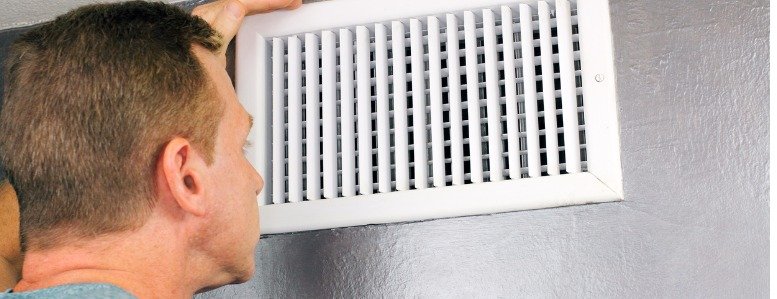Poor Installation:
One of the most common reasons air ducts leak is poor installation. Air conditioned air can escape into unconditioned regions like attics, crawl spaces, or walls if joints and connections are not adequately sealed. The HVAC system’s efficiency drops, and energy consumption and electricity bills go up as a result. It is critical to use duct sealant or metal tape to adequately seal all connections and edges during installation. Ducts should also be well-insulated and attached to avoid damage and keep heat transfer to a minimum.
Age and Wear:
Air ducts are susceptible to natural deterioration as a result of aging, wear, and environmental variables. Deterioration of the metal or fiberglass used to construct ducting can result in fractures, perforations, or disconnected joints. Factors such as moisture, temperature changes, and mechanical stress can worsen this degradation. Air ducts need to be inspected and maintained regularly to detect and fix any symptoms of wear and tear. Restoring the ductwork’s integrity and improving system performance can be achieved by sealing any leaks or replacing damaged portions.
High Pressure and Velocity:
Leaks and other problems can occur when the ductwork is subjected to extremely high velocity and pressure. Inadequately sized ducts, equipment, or airflow are among the potential causes of this. Turbulence and pressure imbalances, caused by airflow velocities that are too high, increase the probability of leaks at connections and joints. To keep airflow at its best and avoid issues caused by pressure, ductwork must be properly designed and sized and maintained on a regular basis.
External Damage:
Pests, insects, construction, and even natural disasters can cause damage to air ducts that are in exposed or vulnerable locations. Construction activities, such as drilling or repair work, can inadvertently puncture ducts, while rats and vermin can cause ducts to be damaged, torn, or crushed. In order to keep air ducts safe from outside forces, it is crucial to set up barriers made of insulation or wire mesh. By keeping an eye out for damage on a regular basis, you can catch it early and fix it before air leaks become a major problem.
Material Degradation:
Air duct leaks can be caused by deteriorating materials as much as by natural wear and tear or by the passage of time. Degradation is more likely to occur with certain materials than with others. One example is flexible ducts constructed from low-quality rubber or plastic. Damage to the ductwork, such as fractures, tears, and brittleness, can be accelerated by exposure to chemicals, high temperatures, and ultraviolet radiation.
In addition, condensation-related problems are more likely to arise if the insulation materials used are of low quality and do not remain effective over time. This reduces the thermal efficiency of the duct system. Leaks and subpar system performance can be avoided with routine inspections and the repair of damaged duct materials.
Vibrations and Movement:
Air duct leaks can also be caused by structural vibrations and movement within the building. The ductwork in a building could move or become dislodged as a result of seismic activity or natural settlement. This can cause the system’s conditioned air to leak out and the unconditioned air to seep in through cracks or separations at joints and connections.
It is critical to secure and support ductwork properly inside the building structure to reduce the effect of vibrations and movement on air ducts. Another option for dampening vibrations and shocks before they reach the duct system is to utilize vibration isolators and flexible connectors.
Lack of Maintenance:
Air duct leaks can worsen preexisting problems and lead to their development if routine maintenance and cleaning are neglected. Obstruction of airflow, elevation of pressure, and acceleration of duct material deterioration can result from dust, debris, and microbiological development within the ductwork. Filters that are unclean or clogged can also limit airflow, which puts more strain on the system and causes pressure imbalances.
Preventing air duct leaks and maximizing the HVAC system’s performance and efficiency over time requires a thorough maintenance program that incorporates routine inspections, cleaning, and filter replacement. Improving indoor air quality and lowering the risk of system malfunction can be achieved through professional duct cleaning services, which remove accumulated dirt and impurities.
Inadequate Sealing:
Air ducts might continue to create leaks despite correct installation if the seals are inadequate. In order to stop air from leaking out, it is essential to seal all joints and connections using the right materials. However, conditioned air can escape and unconditioned air can enter the system if the installation was not properly sealed or if the sealing materials were of poor quality.
Common problems with duct sealing include air gaps, leaks at vents, registers, and duct transitions, and insufficient sealant or tape application. When these spaces expand and contract with temperature changes, air can leak out more easily and the system’s efficiency drops.
Design Flaws:
Air duct leaks can also be caused by poorly built duct systems. Ductwork strain, air turbulence, and high pressure drop can be the outcome of poor design choices such as wrong dimensions, inefficient arrangement, and insufficient support. The HVAC system’s overall performance and efficiency can be compromised if these faults cause leaks at joints, connectors, and duct bends.
To find and fix possible problems that cause air duct leaks, it is necessary to conduct a comprehensive analysis of the duct system’s design. Optimizing airflow distribution, minimizing pressure drop, and reducing the danger of leaks can be achieved by making layout modifications, duct sizing improvements, and structural upgrades. If you want your HVAC system set up to provide you the most comfort and efficiency, it’s a good idea to work with experts that have experience in duct design and optimization.


